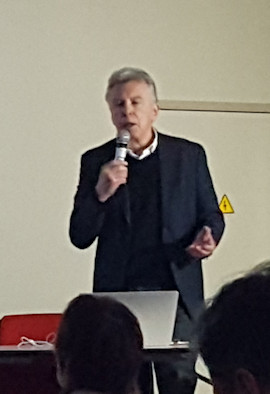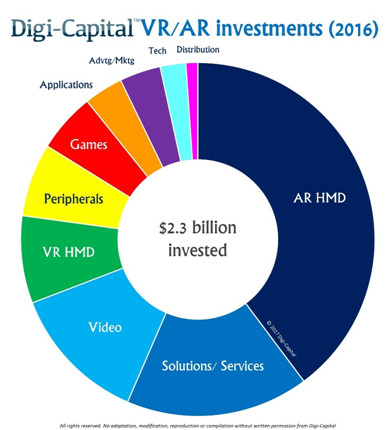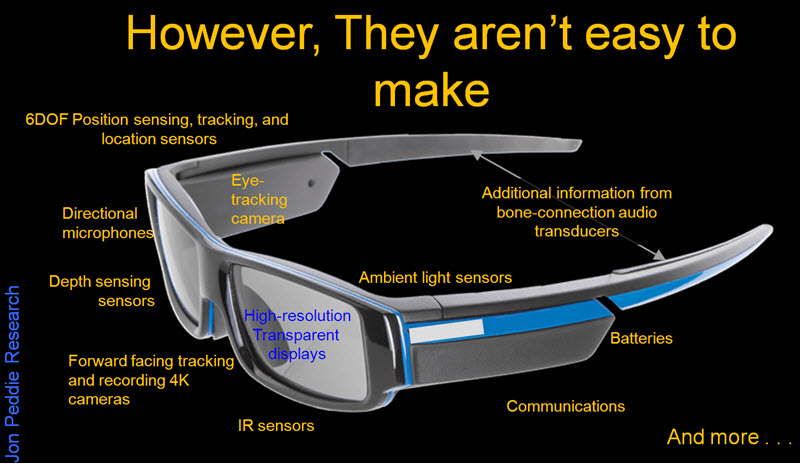 Dr Jon Peddie started his talk by saying that Laval Virtual should be called Laval Immersive because it covers not only VR, but also AR and Mixed Reality.
Dr Jon Peddie started his talk by saying that Laval Virtual should be called Laval Immersive because it covers not only VR, but also AR and Mixed Reality.
The market for these technologies is still developing and although there are still serious technical challenges, he has confidence they will be solved, it will take time, so don’t believe the hype, he said, about how quickly this will be a big market.
He then showed a detailed ‘Taxonomy of AR’ which might be helpful to understand the different ways that the business is developing.
The market will be complicated. For example, technical issues may mean that different devices need to be used indoors and outdoors . Helmets for AR will not be suitable for most users, although there may be commercial and industrial applications that need this kind of mount.
JPR has counted the companies that are currently in the market and he summarised them as :
- Contact lens – 7
- Helmet – 7+
- HUD – 10+
- Smart glasses
- Commercial – 26
- Consumer – 17
- Add ons – 14
- Projectors (not huds) – 3
- Specialised and other – 6+
The number of augmented reality companies has been affected by specific events. Image:Jon Peddie Research
Peddie sees a lot of confusion between devices intended for consumer and commercial applications . For example, he said, he hears people say ‘I wouldn’t wear a hololens’, but the Hololens is for industrial use, in his view. Google glass is still being used in industry.
Contact lenses are a very interesting long term technology but there are many challenges – including both optics and power delivery.
Many products have been announced, in a variety of categories, but much fewer are actually shipping. Some firms are define shipping as jsut a handful or beta volumes, while others define shipping as true mass production. At the moment, the hype is out-running the reality. Venture Captialists (VCs) are very interested in the VR market as a route to AR, which will be more important in the longer term. Paddie said that he has several bets with friends that, by 2020, most normal people will be using AR glasses. Others won’t know that they are not just optical glasses.
By 2020, most normal people will be using AR glasses
He then compared the different market forecasts from fims and they show a wide variation – ‘even a genius like Jon Peddie doesn’t know’, he quipped. There is not even any agreement about definitions of what constitutes ‘the VAR/AR market’. Does it include software and tools, for example?
 Peddie Showed this chart from Digi Capital showing where the business has been so far
Peddie Showed this chart from Digi Capital showing where the business has been so far
JPR bases its forecasts on unit shipments – that’s the best way, in his view. However JPR’s numbers are the smallest ones currently – an illustration that ‘reality is not always pleasant’, he said.
Hardware is Less than Half
Hardware is a big piece but less than half. He showed a chart of the number of companies that have been active in the market and it show spikes associated with specific events. He said that one of the first general interest articles was in ‘Esquire magazine’, which wrote about AR in 2006. This generated interest, but did not provoke an entry by many companies. Project Glass had a larger stimulus, partly because of the component supply chain that was built by Google. Microsoft’s hololens also caused a spike. Then came the Pokemon craze last summer.
The inspiration for A/R came from the industrial/military/scientific segments and technical work started in the 1980s. There were no parts available and building a system was very difficult. Only governments could afford them. Smartphone costs and the volumes which have driven component prices down have allowed a lot of reduction in price.
Smart glasses will be expensive initially – but the price will come down because of volumes and because of the effects of Moore’s law. Peddie thinks that by 2025 contact lenses will be widely adopted once the power transfer problem is solved. He said that the manufacturing cost will be ‘very small’, so the market will leap in volume very quickly. Makers will also have to solve the problems of projecting an image that the eye can recognise and that is not trivial.
AR/VR or MR?
AR is complicated because you have to mix the real world and the virtual world. Peddie compared optical see-through with video see through (using video will have drawbacks but many applications).
A camera is important for figuring out what you are looking at. The number of cameras can be large – possibly four on the front – one for visuals, plus a depth device, a 3D camera and an infrared camera (which of course is measuring light that the user can’t see). The idea of tracking invisible light could be extended to include a uv camera. There will be benefits from having a gaze camera plus one to track the movement of the eyes and another one for looking at the user’s facial features. Another useful camera is a rear view camera and you could have 10 cameras on your head and they could all be different cameras.
Systems need to capture the user’s pose, so it’s important to know where the camera is looking. Peddie said that capture will be a significant use of AR devices and for many users they will be a ‘personal black box’ that records conversations and interactions. (As he pointed out later in the talk, the use of video by onlookers and by police is changing how interactions with the police interact with the public in the US.)
SLAM is not a ‘Slam Dunk’
Accurate registration of the real world and the virtual world is needed.
Simultaneous localisation and mapping (mapping the environment while keeping track of where the user is in a space) or SLAM needs lots of accurate markerless data points from a camera (or preferably three). There are seven companies building SLAM systems to track the world. Nobody knows how to do it ‘that well’.
“Where do you put the cameras?” is a big question. The headset must be light – you really can’t have a lot of batteries or sensors. Designers really need to exploit the smartphones which users already have. The idea would be that the headset uses bluetooth to talk to a smartphone. Can you replace smartphone, Peddie asked? No, there is just ‘too much stuff’ needed for an AR system to be independent.
 AR will not be easy – there could be 10 cameras in a headset. Image:Jon Peddie Research
AR will not be easy – there could be 10 cameras in a headset. Image:Jon Peddie Research
If You are Safer, do You Take More Risk?
AR has a lot of benefits it can make you feel safer, but it can have an unexpected side effect. If you feel safer, you are prone to take more risks and that can rebound. According to researchers, more than 55% of internet users would like AR to light up dark surroundings and to highlight potentially dangerous objects to make them safer. However, the idea of being able to modify your visual field and change how the environment looks may have a variety of consequences. For example, Peddie said, you could decide that you don’t want to see bums on the street – or children, or trash, or certain signs or even grafitti.
Equally, as well as hiding things, you can see things that are hidden like ‘the Terminator’. Peddie can see AR being used to find hidden things. e.g. piping or electrical or gas for construction using CAD data. To reach mass volumes, AR may depend on subsidisation like phones and that may be a problem – could you be overwhelmed with information, so it will have to be managed.
Problems Exist for AR
The Google Glass failed because of its conspicuousness and fear is driven by ignorance, Peddie believes, so more knowledge about AR will reduce fear and allow the category to develop. You can get help to do new things using AR.
In the future you will wonder how you managed without AR, and that won’t take too long, but AR is very tricky – there’s a lot of stuff that has to be got right.

In conclusion, the market will grow and the sensor business is going to be a key industry for growth, there could be a good market for chemical and radiation sensors, for example. Data will need protecting and controlling and that will be a challenge. Augment reality is “Where we will all live”
In questions – Peddie said that you can share A/R experiences via the cloud – but that depends on your acceptance of some latency. 5G may help to reduce latency in sharing, but Peddie believes that 5G will roll out slowly. In response to another question, he said that Magic Leap – “is a risky bet” with difficult optics and that the firm is possibly a year behind or more.
Dr Peddie is just about to see his book “Augmented Reality – Where We Will All Live” released by Springer.

